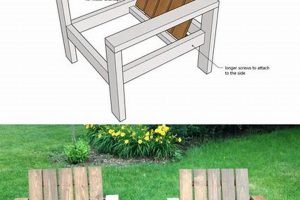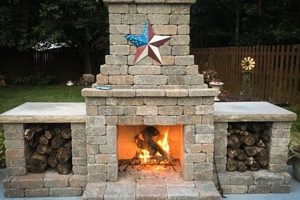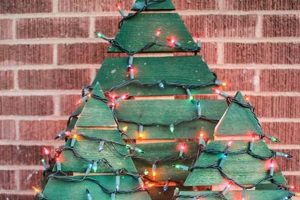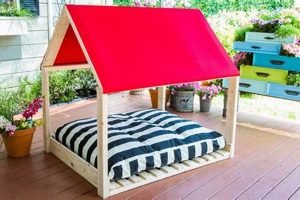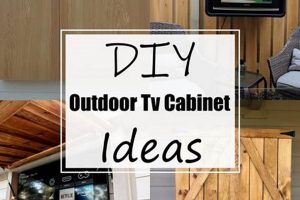A self-constructed, open-air enclosure designed to house rabbits is a common backyard project. This type of structure provides shelter and security for domesticated rabbits while allowing them access to fresh air and sunlight. The typical enclosure incorporates a wire mesh cage elevated off the ground with a solid roof for weather protection and a ramp providing access to a ground level run for exercise.
Constructing a suitable habitat promotes the well-being of rabbits by providing a safe and comfortable living space. Historically, these enclosures allowed owners to keep rabbits for both companionship and as a sustainable source of food. This practice offers control over the animals’ environment, minimizing the risk of predation and exposure to harsh weather conditions, thus ensuring their health and safety. Furthermore, a well-built, customized enclosure integrates seamlessly into outdoor spaces and allows the owner to taylor the design to the rabbit’s size and activity level.
The subsequent sections will detail the planning, material selection, construction steps, and maintenance procedures involved in building a durable and effective outdoor rabbit enclosure. Considerations for weatherproofing, predator protection, and ensuring the animals’ welfare will be thoroughly examined.
Essential Construction Insights
The following points offer key considerations for constructing a secure and practical outdoor rabbit enclosure, addressing both the physical structure and the animal’s well-being.
Tip 1: Material Selection. Prioritize weather-resistant materials such as treated lumber and galvanized wire mesh. Untreated wood is susceptible to rot and decay, while non-galvanized mesh can rust and weaken over time. Cedar wood is a naturally rot resistant wood but may still require sealant.
Tip 2: Elevated Design. Construct the enclosure with a raised floor. This elevation minimizes contact with ground moisture, improving sanitation and protecting against ground-level predators like snakes or rodents. Ensure the elevation is no higher than 2 feet to limit injuries.
Tip 3: Secure Enclosure. Employ a fully enclosed design, including a wire mesh bottom or a solid, buried perimeter, to prevent digging predators from accessing the rabbits. Secure the wire mesh firmly to the frame with staples and avoid gaps. Heavy gauge hardware cloth (1/2″ or 1/4″) is preferred over chicken wire.
Tip 4: Weather Protection. Incorporate a solid roof to provide shade and shelter from rain and snow. Overhangs can further protect the sides of the structure from inclement weather. Consider additional shade cloth or tarps during hot weather.
Tip 5: Ventilation. Ensure adequate ventilation to prevent the build-up of ammonia and moisture. Position the enclosure in a well-ventilated area and incorporate ventilation openings at the top of the structure. Proper ventilation reduces the risk of respiratory illnesses.
Tip 6: Accessible Cleaning. Design the enclosure with easy access for cleaning. A hinged roof, removable trays, or a large access door facilitates the regular removal of waste and maintenance of a hygienic environment.
Tip 7: Size Considerations. Design to the size of the rabbit. A single rabbit should have at least 8 square feet of floor space, while larger breeds or multiple rabbits require significantly more room. Vertical space is also important for rabbits to stand on their hind legs.
These considerations emphasize structural integrity, safety, and the health of the rabbits. Adhering to these tips contributes to creating a durable and comfortable outdoor habitat.
With a foundation of solid planning and construction principles, maintaining the enclosure becomes a manageable task, ensuring a long-lasting and beneficial environment for the animals.
1. Secure Structure
The integrity of a self-constructed open-air rabbit enclosure is paramount, directly impacting the safety and longevity of the habitat. A secure structure, built upon sound construction principles and durable materials, provides essential protection against external threats and ensures the animals’ well-being within their living space.
- Material Strength and Durability
The choice of materials significantly influences the overall security. Using pressure-treated lumber or naturally rot-resistant wood like cedar provides a strong framework resistant to decay and weathering. Heavy-gauge wire mesh, securely fastened with staples or screws, forms a robust barrier against predators. Substituting flimsy materials, such as chicken wire, compromises security, rendering the enclosure vulnerable to breaches by determined animals. Material strength and longevity are crucial facets of creating a safe outdoor habitat.
- Joint Integrity and Fastening
How the enclosure is assembled is as important as the materials used. Joints must be reinforced with screws, bolts, or strong adhesives to withstand stress and prevent separation. Weakly constructed corners or poorly attached wire mesh offer potential access points for predators or escape routes for the rabbits. Reinforcing weak points with metal brackets or additional fasteners strengthens the entire structure. Attention to the connection points ensures the stability and security of the enclosure over time.
- Predator-Proofing Mechanisms
The enclosure’s design should actively deter predators. Burying the wire mesh perimeter extends the barrier underground, preventing digging animals from accessing the rabbits. Secure latches on doors and access panels prevent them from being opened by curious or determined creatures. The addition of an overhead roof protects against aerial predators. These features collectively mitigate potential threats, providing a secure environment for the rabbits.
- Structural Stability and Weight Distribution
An uneven or unstable enclosure is vulnerable to collapse, especially during inclement weather. The base must be level and provide adequate support for the entire structure. Weight should be distributed evenly to prevent stress on specific points. Implementing a solid foundation and reinforcing weak areas ensures the enclosure’s stability and prevents it from toppling over in strong winds or under the weight of snow. Structural stability is essential for a safe and lasting habitat.
In essence, a focus on the elements of sound material choice, proper assembly techniques, active predator deterrents, and overall structural integrity is critical when creating a secure enclosure. By prioritizing these considerations, one can provide a safe and lasting home for the rabbits, ensuring their protection and well-being within their self-built outdoor environment. A compromise in any of these areas can lead to a failure of the enclosure and potential harm to the rabbits.
2. Weather Resistance
Weather resistance is a crucial design element in the successful construction of an outdoor rabbit enclosure. The structure is continuously exposed to environmental factors such as precipitation, temperature fluctuations, and direct sunlight. Failure to adequately address these elements directly compromises the integrity of the enclosure and jeopardizes the health and safety of the rabbits. Moisture promotes wood rot and corrosion of metal components, weakening the structural framework. Temperature extremes cause discomfort or even fatal health issues. Prolonged exposure to ultraviolet radiation degrades materials, shortening the lifespan of the entire structure.
Constructing a weather-resistant habitat involves selecting appropriate materials and employing specific building techniques. Pressure-treated lumber resists moisture damage. A solid, overhanging roof provides shelter from rain and direct sunlight. Galvanized wire mesh prevents rust and maintains its structural integrity over time. Sealants and paints protect exposed wood surfaces. Strategically placed ventilation openings mitigate moisture build-up and maintain a comfortable temperature. Careful consideration of these factors enhances the durability and functionality of the enclosure.
Ultimately, effective weather resistance translates to a more durable, sustainable, and comfortable outdoor living space for rabbits. Ignoring these principles can lead to costly repairs, increased maintenance, and potential harm to the animals. A well-planned and executed design that prioritizes weather resistance ensures the longevity of the enclosure and the well-being of its inhabitants.
3. Predator Prevention
Effective predator prevention is a non-negotiable element in the design and construction of an open-air rabbit enclosure. The inherent vulnerability of domesticated rabbits necessitates a robust defense against a range of potential threats, including terrestrial and avian predators. Failure to implement adequate protective measures exposes the animals to significant risk of injury or death. The selection of materials, construction techniques, and overall design play crucial roles in mitigating these dangers. A well-executed structure not only physically protects the rabbits but also provides them with a sense of security, minimizing stress and promoting overall well-being. Examples of common predators include foxes, coyotes, raccoons, domestic dogs and cats, hawks, and owls, each requiring specific preventative strategies.
Implementing predator-resistant features involves several key considerations. A fully enclosed structure, including a wire mesh bottom or buried perimeter, prevents digging predators from accessing the rabbits. Secure latches on doors and access panels deter unauthorized entry. The use of heavy-gauge hardware cloth, rather than chicken wire, resists tearing and penetration. Overhanging roofs or netting provide protection from aerial attacks. Motion-activated lights or alarms can further deter nocturnal predators. Regular inspection and maintenance of the enclosure are essential to identify and address potential weaknesses. Practical application of these measures significantly reduces the likelihood of predator intrusion.
In summary, predator prevention is an indispensable component of a safe and functional outdoor rabbit enclosure. By carefully considering the specific threats in a given environment and implementing appropriate protective measures, rabbit owners can create a secure habitat that protects their animals from harm. Neglecting this critical aspect exposes the rabbits to unacceptable risks and undermines the purpose of providing a safe and comfortable outdoor living space. The ongoing commitment to vigilance and maintenance ensures the continued effectiveness of these preventative strategies.
4. Adequate Ventilation
Adequate ventilation is a crucial component of any self-constructed open-air rabbit enclosure. The enclosure environment is subject to the accumulation of moisture, ammonia from urine, and heat. Inadequate ventilation exacerbates these conditions, leading to a cascade of adverse effects on the rabbits’ health and well-being. Poor air circulation traps moisture, creating a breeding ground for bacteria and fungi, increasing the risk of respiratory infections such as pneumonia or Pasteurellosis (snuffles). High ammonia concentrations irritate the respiratory tract, causing inflammation and predisposing the animals to secondary infections. Overheating, particularly in warmer climates, can lead to heat stress or heatstroke, both potentially fatal conditions. Therefore, the design and construction must prioritize optimal airflow to mitigate these risks.
The implementation of adequate airflow involves several practical considerations. Positioning the enclosure in a location that receives natural breezes is paramount. Incorporating ventilation openings at the top of the structure allows warm, stale air to escape, while lower openings facilitate the intake of fresh air. The size and placement of these openings should be proportional to the size of the enclosure and the number of rabbits housed within. Solid walls should be minimized to encourage cross-ventilation. Regular cleaning of the enclosure to remove soiled bedding and waste minimizes the sources of ammonia and moisture, further enhancing the effectiveness of the ventilation system. The design should prevent drafts that could chill the rabbits, especially during colder months, by using windbreaks or adjustable ventilation panels.
In summary, adequate ventilation is indispensable for maintaining a healthy environment within a self-constructed outdoor rabbit enclosure. Insufficient airflow creates conditions conducive to respiratory diseases, ammonia toxicity, and heat stress. Proper enclosure design, strategic placement, and regular maintenance are essential for ensuring optimal ventilation. Overlooking this aspect compromises the well-being of the rabbits, highlighting the importance of integrating ventilation considerations throughout the planning and construction processes. Attention to airflow mitigates health risks and fosters a more comfortable and sustainable habitat.
5. Appropriate Dimensions
The provision of appropriate dimensions is a central concern in the construction of a self-built outdoor rabbit enclosure. The physical space allotted directly influences the animal’s welfare, behavior, and overall quality of life. Insufficient space restricts movement, limits exercise opportunities, and exacerbates stress, potentially leading to health issues and behavioral problems. Conversely, an adequately sized enclosure promotes natural behaviors, reduces stress, and enhances the rabbits’ ability to thrive in their environment. Therefore, understanding and adhering to established guidelines for space requirements are essential for responsible rabbit ownership.
- Minimum Space Requirements
Established guidelines dictate the minimum space requirements based on the size and number of rabbits housed within the enclosure. A single rabbit should have at least 8 square feet of floor space. Larger breeds or multiple rabbits necessitate significantly more room. This minimum space allows the rabbit to stretch out fully, stand on its hind legs, and engage in basic movements. Failure to meet these minimums constitutes a form of neglect and compromises the animal’s well-being. Meeting bare minimums may still not be sufficient and should be increased if possible.
- Vertical Space and Height Considerations
Adequate vertical space is as important as floor area. Rabbits naturally stand on their hind legs to observe their surroundings or to reach for food. The enclosure must be tall enough to accommodate this behavior without the rabbit hitting its head on the roof. A minimum height of 2-3 feet is generally recommended. This vertical dimension also allows for the inclusion of elevated platforms or shelves, providing additional space and enrichment opportunities.
- Exercise Space and Run Dimensions
Beyond the main enclosure, access to an outdoor run is essential for exercise and mental stimulation. The run should be significantly larger than the main enclosure, allowing the rabbit to run, jump, and explore. The dimensions of the run should be proportional to the number of rabbits and their activity level. A run measuring at least 4 feet wide and 8 feet long provides ample space for most rabbits to exercise comfortably.
- Multi-Rabbit Considerations and Social Dynamics
When housing multiple rabbits, space requirements increase significantly to accommodate their social dynamics. Rabbits are social animals and benefit from interaction, but insufficient space can lead to competition, aggression, and stress. Each rabbit should have ample personal space to avoid conflict. Providing multiple feeding stations and resting areas further minimizes competition and promotes harmonious cohabitation. An understanding of rabbit social behavior is crucial when determining appropriate dimensions for multi-rabbit enclosures.
In conclusion, the appropriate dimensions of a self-built outdoor rabbit enclosure are fundamental to ensuring the health, happiness, and well-being of the animals. Adherence to established guidelines for minimum space, vertical height, and run dimensions is essential for responsible rabbit ownership. Failure to provide adequate space can lead to a cascade of negative consequences, including stress, illness, and behavioral problems. A well-designed enclosure that prioritizes appropriate dimensions fosters a comfortable and stimulating environment, allowing rabbits to thrive in their outdoor habitat. The careful consideration of these factors throughout the planning and construction phases is critical for responsible animal care.
6. Easy Maintenance
The concept of “easy maintenance” holds significant relevance in the realm of self-constructed, open-air rabbit enclosures. The practicality and sustainability of such a habitat are directly influenced by the ease with which it can be cleaned, repaired, and generally maintained. Designs that prioritize easy maintenance reduce the time and effort required for upkeep, contributing to both the rabbits’ well-being and the owner’s long-term commitment to responsible animal care.
- Removable Waste Trays
The integration of removable waste trays beneath the main living area streamlines the cleaning process. These trays collect urine and droppings, preventing them from accumulating directly on the ground or within the bedding. Regular removal and cleaning of the trays minimize ammonia build-up, reduce odors, and improve overall sanitation. Trays constructed from durable, non-porous materials are easier to clean and disinfect. Examples include plastic or metal trays that slide in and out of the enclosure frame. The dimensions should allow for easy handling without spillage.
- Accessible Cleaning Doors
Incorporating strategically placed access doors facilitates thorough cleaning of all areas within the enclosure. Large doors allow for easy entry with cleaning tools, while smaller doors provide access to specific areas that require frequent attention. The doors should be securely latched to prevent escape. Hinged doors or removable panels are common design choices. The placement of cleaning doors should consider ease of reach and the flow of the cleaning process, minimizing the need to contort or strain during maintenance.
- Durable and Washable Materials
The selection of materials directly impacts the ease of maintenance. Non-porous surfaces, such as sealed wood or plastic, are easier to clean and disinfect than porous materials. Galvanized wire mesh resists rust and can be easily washed. Replaceable bedding materials, such as straw or paper-based litter, simplify waste management. Untreated wood is more difficult to clean and prone to rot, increasing maintenance demands. The careful selection of materials minimizes the accumulation of dirt and bacteria, reducing the effort required for cleaning.
- Simple Structural Design
A straightforward and uncluttered structural design minimizes the areas where dirt and debris can accumulate. Avoid intricate details, narrow crevices, or complex joinery that are difficult to reach and clean. A modular design allows for easy disassembly for deep cleaning or repairs. Streamlined surfaces and minimal obstructions facilitate efficient cleaning and maintenance. Prioritizing simplicity in design reduces the time and effort required for regular upkeep.
In summation, the ease of maintaining a self-built outdoor rabbit enclosure is a significant factor in its long-term success. Designs that incorporate removable waste trays, accessible cleaning doors, durable and washable materials, and simple structural designs reduce the burden of upkeep, promoting both the rabbits’ well-being and the owner’s commitment to responsible care. These facets combine to create a practical and sustainable habitat that requires minimal effort to keep clean and sanitary.
Frequently Asked Questions Regarding Self-Constructed Outdoor Rabbit Enclosures
This section addresses common inquiries and concerns pertaining to the design, construction, and maintenance of open-air rabbit habitats built independently. The information provided aims to offer clarity and guidance based on best practices in animal welfare and structural integrity.
Question 1: What are the minimum space requirements for a outdoor rabbit enclosure?
A single rabbit requires a minimum of 8 square feet of floor space within the enclosure. Larger breeds, multiple rabbits, or increased activity levels necessitate a proportional increase in space. Insufficient space leads to stress, behavioral problems, and potential health issues.
Question 2: What are the essential materials for building a durable outdoor rabbit hutch?
Pressure-treated lumber or naturally rot-resistant wood such as cedar forms a robust frame. Heavy-gauge galvanized wire mesh, securely fastened, provides a protective barrier. A solid roofing material, such as asphalt shingles or metal sheeting, protects against the elements. Appropriate fasteners, such as screws and bolts, ensure structural integrity.
Question 3: How is a diy outdoor rabbit hutch secured against predators?
The enclosure should be fully enclosed, including a wire mesh bottom or a buried perimeter, to prevent digging predators. Secure latches on doors and access panels deter unauthorized entry. Heavy-gauge hardware cloth is more resistant to tearing than chicken wire. Overhanging roofs or netting offer protection from aerial threats.
Question 4: What ventilation strategies are critical in an outdoor rabbit hutch?
The enclosure should be positioned to receive natural breezes. Ventilation openings near the top of the structure allow warm air to escape, while lower openings facilitate fresh air intake. Solid walls should be minimized to encourage cross-ventilation. Regular cleaning reduces ammonia build-up.
Question 5: What considerations are important in weatherproofing a rabbit enclosure?
A solid roof with overhangs provides shelter from rain and sun. Sealants and paints protect exposed wood surfaces from moisture damage. The enclosure should be elevated off the ground to prevent waterlogging. Strategically placed windbreaks offer protection from harsh winds.
Question 6: How is the maintenance of an outdoor rabbit hutch simplified?
Removable waste trays facilitate easy cleaning. Large access doors allow for thorough scrubbing. Durable and washable materials, such as sealed wood and galvanized wire, are easier to maintain. A simple structural design minimizes areas where debris can accumulate. Regular cleaning prevents the build-up of waste and odors.
These answers provide a foundation for understanding key aspects of rabbit hutch construction. The successful construction of a secure and safe enclosure requires diligent planning, meticulous execution, and a commitment to the well-being of the rabbits.
The succeeding section will address the legal and ethical considerations relevant to keeping rabbits in self-built outdoor enclosures, focusing on responsible animal ownership and compliance with local regulations.
Concluding Remarks on Constructing a Self-Built Open-Air Rabbit Enclosure
The preceding discussion has examined the various facets of building a diy outdoor rabbit hutch. Crucial components, including structural integrity, weather resistance, predator prevention, adequate ventilation, appropriate dimensions, and ease of maintenance, have been thoroughly addressed. The successful integration of these principles ensures the provision of a secure and healthy environment conducive to the well-being of the housed animals.
Careful consideration of the outlined guidelines is paramount for individuals undertaking such projects. The commitment to responsible animal care necessitates adherence to best practices in construction and ongoing maintenance. Prioritizing the safety and comfort of the rabbits over expediency will result in a sustainable and ethically sound outdoor living space. Continued vigilance and proactive adjustments are essential to adapt the enclosure to evolving environmental conditions and the specific needs of the animals it houses.


